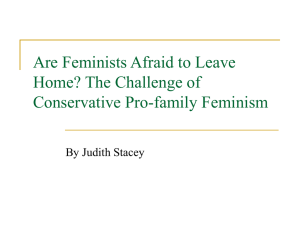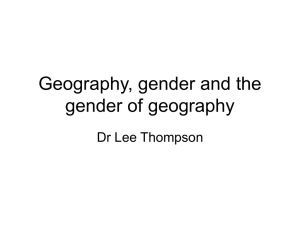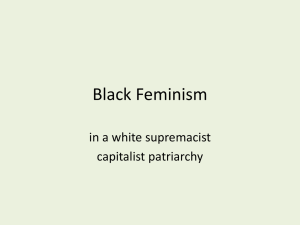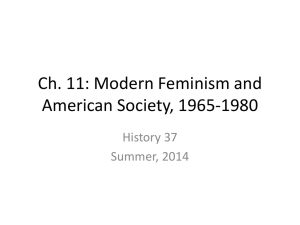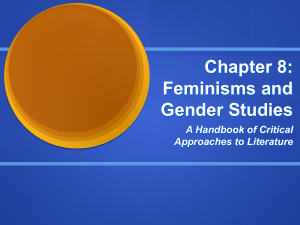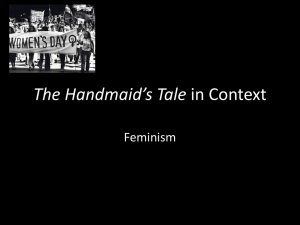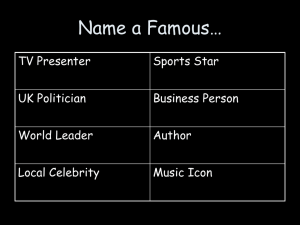Feminist Theory: Part One
advertisement
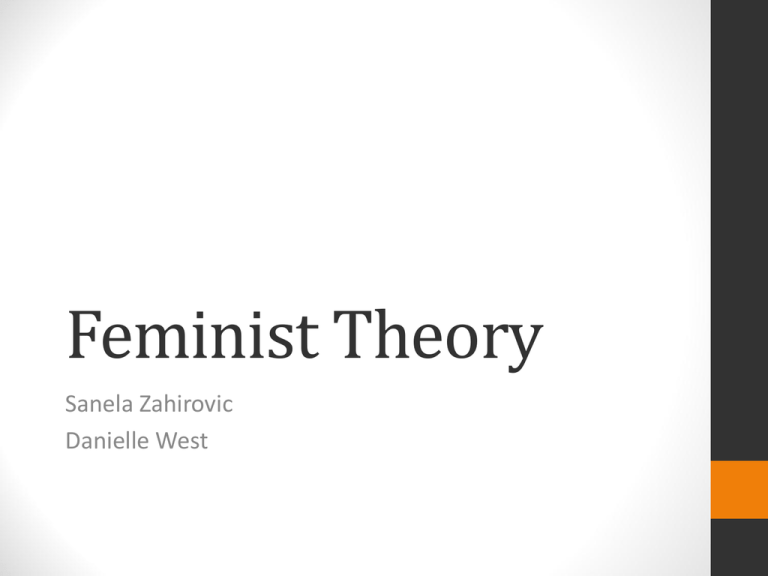
Feminist Theory Sanela Zahirovic Danielle West Feminism and It’s Roots • Feminist theory is an outgrowth of the general movement to empower women worldwide. • Feminism is a women-centered approach to the study of human behavior. • Through analysis of gender roles and gender appropriateness, feminist theory demonstrates how women have historically been subjected to a double standard in both treatment and in the evaluation of their worth. Feminism • Feminism is: a recognition and critique of male supremacy combined with efforts to change it. • Feminists fight for the equality of women and argue that women should share equally in society’s opportunities and scarce resources. First Women’s Convention • Seneca Falls, New York, 1848 (Birthplace of Feminism) • More than 300 people attended • Discussed social, civil, and religious condition of women • Marked the beginning of a 72 year battle to gain right to vote in the US • 1920, US became 17 country in the world to give voting rights to women. New Zealand was the 1st-1893. • Declaration of Sentiments Declaration of Sentiments • First draft written by Elizabeth Cady Stanton • Modeled on Declaration of Independence • Paragraph 2 states: “We hold these truths to be selfevident; that all men and women are created equal; that they are endowed by their creator with certain inalienable rights; that among these are life, liberty, and the pursuit of happiness; that to secure these rights governments are instituted, derived their just powers from the consent of the governed” Feminism in Germany • Feminism though led by Marianne Weber in early 20th century Germany. • Active attempt to reach economic and political equality between men and women • 1905, another German feminist group emerged. • Concerned with sexual autonomy, led to what is known as erotic movement. • Helen Stoker became the leader of erotic movement in 1906. Issues of sexual politics and matrimonial law became the focus-Right of women to engage in sexual relations regardless of marital and legal considerations Max and Marianne Weber • Criticized these women • Believed the promoted rights of “free love” and “illegitimate” children. • View the erotic movement as unethical and hedonistic • Marianne Weber, agreed with her husband • Ehefrau und Mutter in der Rechtesentwicklung-1907 • Believed that women’s movement should focus on equality of women and not sexual and moral emancipation. • Women should be financial independent • Paid for domestic chores • Women should be treated equally in social institutions of marriage • Believed in marriage between man and woman only • Alienated many other feminists (especially lesbian feminists) Contemporary Feminist Movement • Second wave of Feminism-1960s • “Free love” helped women escape the sexual double standard • Divorce became easier to obtain • Women found fulfillment outside the home. • Focused on women having equal rights and reaching this goal through legal reform and legislating antidiscriminatory policies Contemporary Feminist Movement • Examining the race-class-gender linkage originated with African American feminists in the 1960s. • Feminization of Poverty • Women more likely then men to be poor • Usually single women, women of color and elderly women living alone • Mainstream white feminists often negligent of the reality of women of color • More concerned with poverty than disadvantages associated with gender Liberal Feminism • Most mainstream perspective • Based on idea that all people are created equal and should not be denied equal opportunity based on gender • Best exemplified by National Organization for women (NOW) • Formed in 1966 • Works within established socioeconomic and political systems to advocate social change on behalf of women Liberal Feminism • Obstacles to equality lie in traditional laws and behaviors • Primary obstacle is sexism • Sexists attitude about appropriate gender roles for men and women continues to lead to discrimination and prejudice against women • Equality also hampered by women who are reluctant to exercise their rights • Strive for equality and civil rights for all individuals Liberal Feminism • Equality is best accomplished through programs that prohibit discrimination and education program that teach children that society's roles are not gender-specific • Ex. men-doctors, women-nurses • Educating that gender roles are learned not innate • Criticized for failing to explain institutionalized social classes and racial oppression Marxist Feminism • Similar to thoughts of Karl Marx and conflict theory • Division of labor was related to gender role expectations • women-homemakers, men-breadwinners • Means of production controlled by men • Women exploited by existing social systems • Working class women are paid less then their male counterparts Marxist Feminism • Social system needs to change to the point where women have equal access to the control of the means of production • Steps to equality • First step: entering workforce • Second step: advancing to management • Ultimate goal: women owning the means of production • Acknowledged class differences • Invites all women to understand that the women’s oppression is the product of political, social, and economic structures associated with capitalism Radical Feminism • Views patriarchy as sexual system of power in which male possesses superior power and economic privilege • Sexism is the ultimate tool used by men, to keep women oppressed • Male power and privilege is the basis of social relations • View patriarchy as having emerged from men’s attempt to control, females sexuality • Through patriarchal gender socialization • Creation of norms of acceptable sexual behavior • Men exercise sexual power in many violent forms • Rape, incest, sexual harassment and battery • Not always physical-ex. encouraging certain style of dress, motherhood, unpaid housework Radical Feminism • Heterosexuality as a tool of male dominance • Many ways to escape the cage of femininity • Androgynous culture, replacing male culture with female culture, celibacy, lesbianism • Refusing to reproduce is the most effective way for women to escape • All existing structures are created by men • Ex religion: God is male. Socialist Feminism • Women’s oppression as stemming from their work in the family and economy • Inferior positions of women in the social system is the result of class-based capitalism (similar to Marxist Feminism) • Ex. Unpaid housework • Capitalism is not the only cause • Attempts to adapt socialist principles to both the workplace and at the home to increase gender equity • Social change will occur through increased consciousness and knowledge of how society’s social structures are designed and operate to oppress women Socialist Feminism • Private and public sphere • Men-public (workplace), women-private (home) • Private-invisible • Argue for two things: • 1. An increased emphasis on the private sphere and the role of women in household • 2. Equal opportunities for women in the public sphere Postmodern Feminism • Attempt to criticize the dominant order and to valorize the feminine woman • Utilizes postmodern theory and its assumption that we no longer live under conditions of modernity, but of postmodernity • Postmodern world is a global world highlighted by technology that controls and promotes consumerism Postmodern Feminism • Believe that concepts and outlooks used to examine the world in the past no longer apply to the analysis of the world today • All theory is socially constructed and resent the claim of modernists that only rational, abstract thought and scientific methodology can lead to valid knowledge Dorothy E. Smith • Born: 1926 in Great Britain • 1955: B.A. in sociology from London School of Economics • 1963: Ph.D. in sociology from U of California at Berkeley • Feminist thinking and sociological approach are deeply influenced by experiences of being a lecturer at Berkeley in an almost all-male staff and being a single mother. Bifurcation “conceptual distinction between the world as we experience it and the world as we come to know it through the conceptual frameworks that science invents” • Attempt to expose gender-biased assumptions within the social sciences • Male-power-based gender construction of roles has legitimized gender inequality in society • Proposed reorganization of sociology Sandra Harding Born: 1935 • Professor of education and women’s studies at UCLA • Director of the Center for the Study of Women • Leading feminist and philosopher who taught for two decades at University of Delaware • Given over 200 lectures internationally and has served as a consultant to UN organizations. Feminist Theory • Criticized all sociological theories • Does not believe in idea of universal theory, but specific theories should be designed for specific categories of people • Empirical research is biased • Believes all males and all whites benefit from their ascribed status (ignores empirical data like the poor, war vets, and homeless) Neutrality and Objectivity in Science • Science is male-dominated, biased, and lacking in objectivity • Objectivist methods are encouraged to eliminate the social and political values and interests of researchers • Encouraged women to stop disagreeing among themselves and encourage more feminists to enter science. (For whistleblowing purposes Patricia Hill Collins • • • • Born: 1948 in Philadelphia 1969: B.A. from Brandeis 1970: M.A. from Harvard 1984: Ph.D. from Brandeis • Sociological concerns mirror experiences as an African American woman who broke many barriers and who often felt marginalized. • Outsider within: (Similar to Simmel’s idea of the stranger) One part of the group feels distanced from the group. Feminist Theory and Methodology • Believes that the focus of sociological theory should be the “outsider” groups that usually lack a “voice” in scientific framework • Promotes using subjective analysis to study all of these voices • Agrees with Harding regarding white male interests saturating traditional scholarship. • She also rejects empirical data and statistical analysis in favor of documentation of voices of black women in all social settings. Theory and Methodology Con’t • Collins describes positivism as “Eurocentric masculinist” • Emotional components like feelings are important in the gathering of knowledge. • Values SI approach • Individual level of analysis Black Feminism • Ideas produced by Black women that clarify a standpoint of and for Black women • 1. The meaning of self-definition and self-valuation: • Studying social reality of Black women • Take that self image to black women learning to value themselves and empower themselves in societal structure • 2. The interlocking nature of oppression: • Society has taught black women that racism, sexism, and poverty are inevitable for them and keep them oppressed • Awareness will empower and unite to fight system • 3. The importance of African-American women’s culture • Examination of family life and relationship between mother/child (expectations and perceptions)


